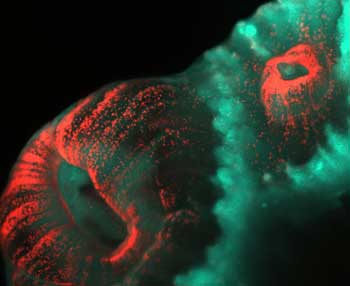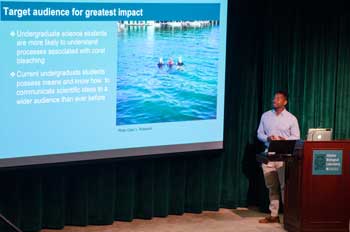My Crash Course in Light Sheet Microscopy

A lot like tourists visiting the Caribbean, corals need warm, clear water and just the right amount of light every day -- otherwise, they get very stressed out. With too much heat or light, the stress builds up until the coral expels the photosynthetic algae that live inside it, providing both food and beautiful color. This expulsion event, aptly named bleaching, leaves the coral with only its white, calcium-carbonate skeleton. In this condition, without a source of energy, the coral is susceptible to disease and eventual death.
 The northern star coral (Astrangia poculata). Credit: Pierre Phillipe Laissue
The northern star coral (Astrangia poculata). Credit: Pierre Phillipe LaissueThe sensitivity of living corals is both a motivation for using microscopes to better understand them, and an obstacle to studying them in the lab. Traditional microscopes use slides for mounting samples that don’t allow the space or water that corals need to survive. Enter Pierre Phillipe Laissue, an MBL Whitman Center awardee last summer from University of Essex, U.K. Laissue has developed a microscope system, called L-SPIM, that is built for comfort! It has a variety of sample chambers made from glass and aluminum that give corals plenty of space to stretch their tentacles.
Equally important, the microscope’s use of “light sheet” technology allows the scientist to focus light on single planes, or vertical sections, of a given sample. This greatly reduces the amount of light stress the corals experience while being imaged, without sacrificing too much resolution. So the scientist can get a picture perfect image of the lively corals: a win-win!
 Gyasi Alexander presents at the 2017 MBL Undergraduate Research Symposium. Credit: Emily Zollo
Gyasi Alexander presents at the 2017 MBL Undergraduate Research Symposium. Credit: Emily ZolloLaissue collaborated this summer with MBL Associate Scientist Loretta Roberson, who studies corals and coral bleaching. I spent the summer in Roberson’s lab through the Research Experiences for Undergraduates (REU) program. At the beginning of the summer, I had never even heard of light sheet microscopy. In fact, my experience with microscopes had been limited to the compound light and dissecting scopes I would get my hands on ever so often in general biology lab. I could never have imagined the whole new world that I discovered at the MBL, through the oculars of confocal, wide field, and – my new muse – light sheet microscopes.
Gyasi Alexander is a Gates Millennium Scholar at University of Rhode Island and participated in the 2017 Biological Discovery in Woods Hole (REU) program at MBL.